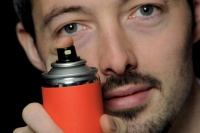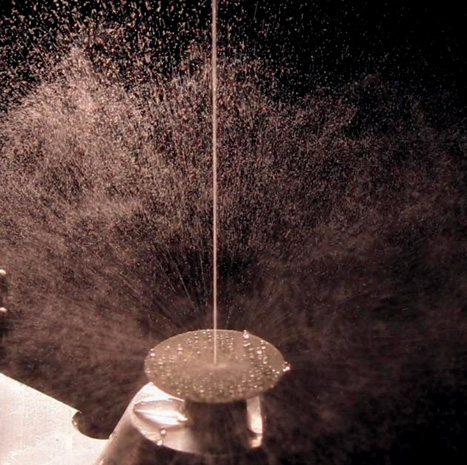Engineers at Cambridge-based 42T are investigating an aerosol technology that has the potential to eliminate pressurised propellants from personal and household aerosol canisters.
Conventional aerosol cans contain both a propellant and any number of products such as a deodorant or insect repellent. When a small valve on the canister is depressed, the high-pressure propellant gas forces both the propellant and small droplets of product out through a nozzle.
Many types of propellant have been used by aerosol manufacturers over the years. These include chlorofluorocarbon (CFC), hydrochlorofluorocarbon (HCFC) and hydrofluorocarbon (HFC), as well as other volatile organic compounds (VOCs) such as butane.
However, as a result of concerns about their impact on the ozone layer, the use of both CFCs and HCFCs is to be totally abolished in accordance with the Montreal Protocol, leaving HFCs and VOCs as the only alternative options.

’To mimic the properties of the Lotus leaf, several leading academic groups including those at Cambridge University’s Cavendish Laboratory and the Massachusetts Institute of Technology (MIT) in the US have developed man-made superhydrophobic materials for commercial applications,’ said Biddle.
One superhydrophobic material developed at the Cavendish Laboratory was created from a mixture of PTFE and micron-sized polystyrene balls coated onto a surface. Once heated to a high temperature, the polystyrene balls evaporate, leaving pock marks in the fused PFTE surface.
At MIT, an alternative superhydrophobic material was created by anodising a foil of aluminium, with the result that the surface structure comprised numerous micron-scale, hexagonal holes of alumina that could then be coated in silane to enhance its hydrophobic properties.
’To see if such materials would produce droplets of sufficient quantity when used in conjunction with an impact aerosol technique, we conducted a series of experiments, firing jets of water at a number of different surfaces and observing the results,’ said Biddle.
In their work, the researchers realised that one key parameter called the Weber number might provide them with an indication of how well any surface would produce droplets. That parameter a dimensionless number in fluid mechanics is useful in analysing the formation of droplets since it relates the density of the fluid, its velocity and its surface tension with the droplet diameter.
“When designing a deodorant aerosol, you want the droplets to be between 20μm and 30μm in diameter”
HOWARD BIDDLE, 42T
Naturally enough, initial investigations showed that when a drop of liquid hit the surface of the superhydrophobic material it spread out. As it did so, a corona formed owing to air and surface resistance. At some point, the leading edge of the corona then broke up into uniformly sized droplets a valuable feature for any potential uses of the technique in an aerosol. But only at high enough Weber numbers did the satellite drops on the corona have enough momentum to leave the surface of the material.
The 42T team then calculated how the pressure of the liquid fired at the surface of the superhydrophobic material related to the size of the droplets produced and how these parameters were affected by the energy conversion efficiency of the material used.
Theoretically, the researchers surmised that superhydrophobic materials with an energy conversion efficiency of 100 per cent should produce 20μm droplets at a pressure of around 0.25 bar. Smaller 5m droμplets could be created at the somewhat higher pressure of 0.75 bar.
The team also examined the effect of changing jet input pressure and diameter and conducted comparative tests on a range of surfaces including the superhydrophobic materials from the Cavendish laboratory and MIT. Early experiments showed that it was possible to create an aerosol of droplets of around 20-30μm with a waterjet pressurised to as little as 1 bar.
’When you design an aerosol to dispense a personal product such as a hair spray or a deodorant, you want the droplets to be between 20μm and 30μm in

diameter,’ said Biddle. ’On the other hand, for pharmaceutical applications, droplets of 5μm in diameter can be created that could be inhaled directly into the alveoli of the lung.’
He added that designing a practical product based on the concept would potentially be relatively straightforward. An aerosol would only need a simple trigger pump to pressurise a liquid inside the container, which would then be propelled towards an angled superhydrophobic surface.
The droplets formed from the impact would then emanate from the can through an orifice.
When exposed to rain, droplets of water roll off Lotus leaves, taking with them any dust particles
As exciting as the concept sounds, Biddle pointed out that commercial applications for the technology might be some way off. Currently, the company is looking for sponsorship from interested parties to continue its work quantifying the characteristics of a range of superhydrophobic materials and jet types as well as examining how the pressure of liquid might affect the wetting properties of the superhydrophobic materials and hence their efficiency.
Nevertheless, Biddle is confident that the technique looks promising enough that it might one day provide aerosol manufacturers with an alternative to chemicals such as HFCs and VOCs and hence help to stem the advance of global warming.
’Conventional aerosol cans have to be large and strong enough to safely maintain the product and a considerable volume of HFC or pressurised inflammable propellant, making them costly to manufacture and recycle,’ he said.
’Our approach would enable manufacturers to produce propellant-free aerosols but in smaller, less expensive packaging. And unlike some alternative technologies that use compressed nitrogen where the performance deteriorates through use the droplet size would be maintained until the can’s contents were completely emptied.’

Glasgow trial explores AR cues for autonomous road safety
They've ploughed into a few vulnerable road users in the past. Making that less likely will make it spectacularly easy to stop the traffic for...